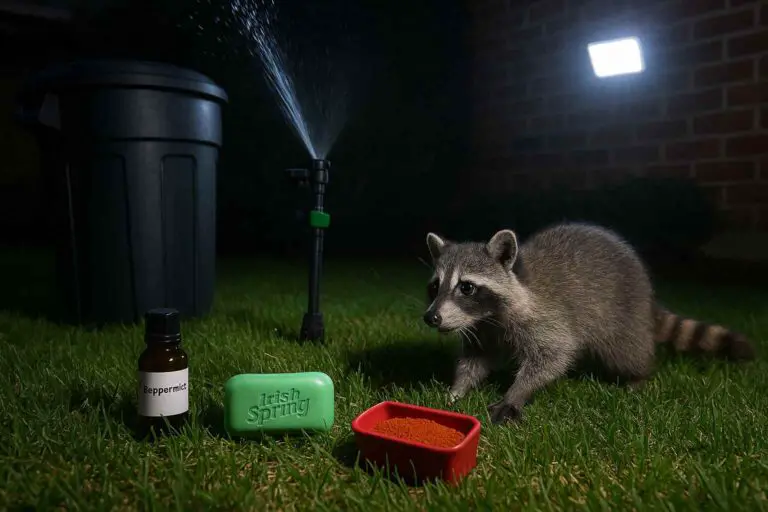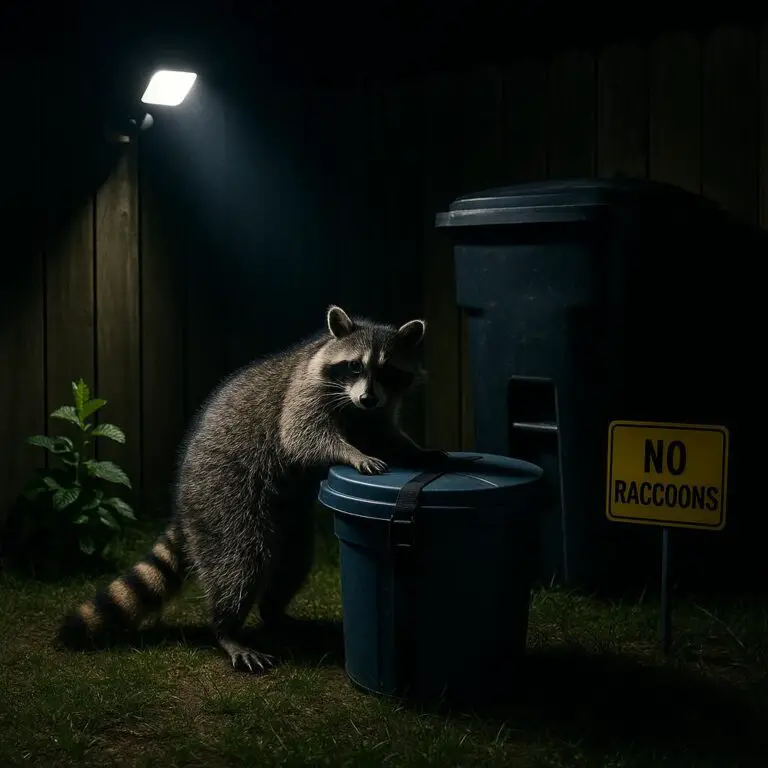Are you tired of pesky animals wreaking havoc in your garden or causing trouble around your property? Well, you’re not alone! As a fellow nature lover, I’ve had my fair share of encounters with furry critters that just couldn’t resist the temptation of my beautiful plants or garbage cans. That’s why I embarked on a quest to find the ultimate solution to keep these intruders at bay. In my quest, I stumbled upon the intriguing concept of solar lights as animal deterrents. You might have heard the claims that these eco-friendly lights have the power to repel animals effectively. But do solar lights really have what it takes to keep these critters away?
Well, solar lights can contribute to deterring animals by providing bright illumination and surprising motion sensors. However, they work best when combined with other strategies like fencing and repellents for comprehensive animal deterrence.
But there’s much more to that. So, if you’re ready to shed some light on the age-old question of whether solar lights can truly deter animals, grab a cup of your favorite beverage, and let’s explore the truth behind this popular belief. Trust me, by the end of this article, you’ll be equipped with valuable insights that can help you reclaim your garden and keep those furry invaders at a safe distance. Let’s get started!
Understanding Animal Intrusions and the Need for Deterrents
Before I dive into the effectiveness of solar lights as animal deterrents, let’s first understand why animal intrusions can be a real nuisance and why finding effective deterrents is crucial.
- Defining Animal Intrusions: Animal intrusions refer to unwelcome visits from our furry and not-so-furry friends that can wreak havoc on our gardens, damage property, and even pose health risks. Common culprits include raccoons, deer, rabbits, squirrels, and many more. These critters can nibble on plants, dig up lawns, rummage through garbage cans, and cause structural damage to our homes.
- Impact on Our Lives: Animal intrusions can be more than just a minor annoyance. They can have significant consequences for both our property and our well-being. Imagine spending hours cultivating a beautiful garden only to wake up the following day to find it ravaged by hungry creatures. Not to mention the mess and potential health hazards caused by animals rummaging through our garbage.
- The Importance of Effective Deterrents: To protect our property and maintain a peaceful coexistence with wildlife, it’s essential to find effective deterrents. A reliable deterrent can discourage animals from entering our spaces, reducing the chances of property damage, disease transmission, and conflicts with humans.
Now that you understand the nuisance animal intrusions can cause and the need for effective deterrents, let’s explore whether solar lights have the potential to keep these critters away.
The Concept Behind Solar Lights as Animal Deterrents
Now that we’re on the same page about the importance of finding effective deterrents, let’s delve into the concept behind solar lights and their potential to repel animals. It’s time to shed some light on the matter!
How Do Solar Lights Work? Solar lights are outdoor lighting fixtures that harness the power of the sun to generate and store energy during the day. They typically consist of a solar panel that absorbs sunlight, a rechargeable battery that stores the energy, and LED lights that illuminate when it gets dark.
The Role of Light in Influencing Animal Behavior: Animals, like humans, rely on natural light cues to regulate their behavior. Light plays a crucial role in their daily routines, including feeding patterns, sleep-wake cycles, and navigation. When it comes to animal deterrents, the idea is to use specific types of light to create an environment that animals find less appealing or threatening.
Claims of Solar Lights as Animal Repellents: Solar lights have been marketed as effective deterrents by some manufacturers and enthusiasts. The theory is that the bright and constant illumination provided by these lights can startle or confuse animals, making them think twice about venturing into our spaces. Some proponents also suggest that the motion sensor feature of certain solar lights can further enhance their effectiveness by triggering a sudden burst of light and scaring off intruders.
While these claims sound promising, it’s essential to examine the evidence and scientific research to determine whether solar lights truly live up to their reputation as animal deterrents. In the next section, I’ll explore the effectiveness of solar lights in repelling animals and separate fact from fiction. Stay tuned!
Examining the Effectiveness of Solar Lights in Repelling Animals
Now that you understand the concept behind using solar lights as animal deterrents, it’s time to dig deeper and examine the evidence regarding their effectiveness. Let’s shine a light on the truth and explore whether solar lights can indeed keep those pesky critters at bay.
Scientific Studies and Research: Several scientific studies have investigated the impact of light on animal behavior and the potential of solar lights as deterrents. While research in this specific area is limited, some studies suggest that bright lights can disrupt the feeding and foraging patterns of certain animals, making them more cautious or inclined to avoid well-lit areas.
Animal Behavior and Responses to Light: Animals have varying sensitivities to different types of light. Some species, such as deer, may be more sensitive to bright light, while others, like raccoons, may adapt and become less affected over time. Factors such as the intensity, duration, and color of the light can also influence their responses.
Limitations of Solar Lights as Sole Deterrents: It’s important to note that relying solely on solar lights as animal deterrents may have limitations. Animals can quickly adapt to repetitive stimuli, including constant light sources. Additionally, different species may have varying levels of tolerance or attraction to light, meaning that solar lights may not be equally effective for all types of animals.
While solar lights can create a deterrent effect to some extent, combining them with other strategies can enhance their effectiveness. Next, I’ll explore additional factors that can influence the efficiency of solar lights as animal deterrents. Stick around for valuable insights on maximizing their potential!
Factors Affecting the Efficiency of Solar Lights as Animal Deterrents
While solar lights can play a role in deterring animals, their effectiveness can be influenced by various factors. Let’s shed some light on these factors to maximize the efficiency of solar lights as animal deterrents.
- Brightness and Intensity: The brightness and intensity of the light emitted by solar lights can impact their effectiveness as deterrents. Bright lights are more likely to catch the attention of animals and potentially discourage them from approaching. Opt for solar lights with higher lumen output for better visibility.
- Motion Sensor Feature: Solar lights equipped with motion sensors can enhance their effectiveness by triggering a sudden burst of light when animals approach. The sudden change can startle animals and discourage them from getting closer. Ensure the motion sensor range and sensitivity are appropriately adjusted for optimal results.
- Light Color: The color of the light emitted by solar lights can also influence animal behavior. While there isn’t a one-size-fits-all color, certain colors like bright white or cool blue might be more effective in deterring animals due to their resemblance to daylight. However, it’s worth noting that different species may respond differently to specific light colors, so experimentation might be necessary.
- Placement and Coverage: Proper placement and coverage of solar lights are crucial for maximizing their deterrent effect. Identify the areas most prone to animal intrusions and strategically position the lights to provide adequate illumination. Consider placing them near entry points, garden beds, garbage cans, or vulnerable areas.
- Multiple Deterrent Strategies: Remember that solar lights should be used as part of a comprehensive approach to animal deterrence. Combining solar lights with other strategies such as fences, repellents, or natural barriers can create a more robust defense system against intruding animals.
Next, I’ll explore alternative strategies that can complement the use of solar lights for optimal results. Don’t leave!
Alternative Strategies for Animal Deterrence
While solar lights can be a valuable tool in deterring animals, they work best when used in conjunction with other strategies. Let’s explore 5 alternative methods that can complement the use of solar lights and create a comprehensive approach to animal deterrence.
- Fencing: Installing fences around your property or specific areas can provide a physical barrier that keeps animals out. Choose fencing materials and designs based on the types of animals you want to deter. For example, a tall fence with wire mesh can be effective in keeping out deer, while smaller gaps or solid fencing may be suitable for smaller critters.
- Repellents: Using animal repellents can be an effective way to deter unwanted visitors. There are various repellents available, including sprays, granules, and electronic devices. Look for repellents specifically formulated for the animals you’re dealing with and follow the instructions for safe and effective use.
- Natural Barriers: Consider using natural barriers to deter animals. This can include planting thorny or prickly plants around your garden, such as roses or holly bushes, which can create an uncomfortable or unappealing environment for animals. Additionally, rocks or gravel beds can create physical barriers that animals are less likely to traverse.
- Scare Tactics: Implement scare tactics to startle and deter animals. This can involve using motion-activated devices like sprinklers or sound-emitting devices that mimic predator noises. These sudden and unexpected stimuli can discourage animals from entering your property.
- Wildlife Habitat Management: Make your property less attractive to animals by removing potential food sources or shelter. Secure garbage cans tightly, eliminate standing water sources and trim vegetation near structures that could serve as hiding spots for animals.
Remember, every property and animal situation is unique, so it may require some trial and error to find the combination of strategies that works best for you.
In the next section, I’ll provide practical tips for using solar lights as animal deterrents, ensuring you make the most of this strategy.
Practical Tips for Using Solar Lights as Animal Deterrents
Now that you’ve explored the various strategies for animal deterrence, let’s focus on practical tips specifically related to using solar lights effectively. Here are six valuable tips to maximize the potential of solar lights as animal deterrents:
- Proper Placement: Identify the areas most susceptible to animal intrusions, such as entry points or vulnerable garden beds. Place solar lights strategically in these areas to provide ample illumination and create a deterrent effect. Consider placing them at a height that is visible to animals.
- Optimal Coverage: Ensure sufficient coverage by placing solar lights at regular intervals, ensuring that the entire target area is well lit. This helps create a consistent and intimidating environment for animals. Adjust the angle of the lights to cover a wide area and experiment with positioning to find the most effective configuration.
- Experiment with Settings: If your solar lights have adjustable settings, such as brightness or motion sensor sensitivity, experiment with different configurations to find the settings that work best for your specific situation. Some animals may be deterred by brighter lights, while others may be more sensitive to motion sensor triggers.
- Regular Maintenance: Keep your solar lights in optimal working condition by regularly cleaning the solar panels to ensure maximum sunlight absorption. Replace any worn-out batteries to maintain optimal performance. Proper maintenance ensures that the lights are functioning at their best, maximizing their deterrent effect.
- Combine with Other Deterrents: Remember that solar lights work best when used in conjunction with other deterrent strategies. Consider implementing additional methods like fencing, repellents, or natural barriers to create a comprehensive defense system against animal intrusions.
- Observe and Adjust: Pay attention to animal behavior and adapt your deterrent strategy accordingly. Animals may become accustomed to certain stimuli over time, so periodically change the positioning of the lights or adjust other deterrent methods to keep them on their toes.
Conclusion
In conclusion, while solar lights can be a valuable component of an animal deterrence strategy, they should not be solely relied upon. Animals can adapt to constant stimuli, and their responses to light may vary.
To effectively keep animals away, it’s important to employ a multi-faceted approach. Combine solar lights with other deterrent methods such as fencing, repellents, and natural barriers to create a robust defense system. By integrating these strategies, you increase the chances of successfully deterring animals and maintaining a peaceful coexistence. So, shine some light, explore different techniques, and enjoy a critter-free space!
Here’s your next read: Will A Porch Light Really Keep Raccoons Away?








